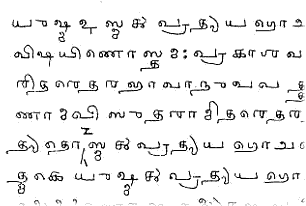SALRC Recommended Fonts
As a resource for language teaching faculty, students, and SALRC-affiliated software developers, the SALRC is assembling a collection of fonts that we believe are best suited for displaying South Asian languages on the computer screen. This site provides practical information about these fonts, including text samples, how and where to get them, and how to install and use them on your computer.
A variety of fonts is commonly available for South Asian languages. Most have limitations of platform (e.g., PC or Mac), operating system (e.g., Windows 2000, XP, OS-X, Unix), or even of software (e.g., Microsoft Word, Wordperfect, Adobe InDesign). Unfortunately, no single font works for all platforms, in all operating systems or with all software. However, since 1992 the Unicode Consortium has been developing a universal set of encoding tables that is rapidly becoming the international standard. In order to regularize the structure of fonts, the Unicode encoding table assigns a unique hexadecimal number for each character in every language. The Unicode scheme not only facilitates the mutual legibility of documents across fonts, but increasingly, Unicode also means compatibility across platforms, operating systems, and software. The SALRC only recommends fonts that are fully compliant with the Unicode standard.
Within this site, the SALRC recommended fonts have been organized by South Asian language, and may be navigated using the menu on the left side of this page. For each font, we have provided textual samples, statistics, and links for downloading the font. In addition, in each language page you will find a discussion of available keyboard input methods for each particular South Asian script, as well as platform and operating system compatibility issues. We have also provided instructions for installing fonts and layouts and configuring web browsers for South Asian fonts.
Currently, the SALRC offers recommendations for: Assamese,
Baluchi, Bengali,
Brahui, Dzongkha,
Gujarati, Hindi,
Kannada, Kashmiri,
Kodagu, Lahnda,
Malayalam, Marathi,
Nepali, Panjabi (Gurmukhi
and Shahmukhi), Sanskrit,
Sindhi,
Sinhala, Tamil,
Telugu, Tibetan,
Tulu, and Urdu.
Additional Resources and Credits
For a more specific discussion of the Unicode standard for Indic languages, a useful site is the Unicode Consortium's FAQ for Indic languages. For general information about the Unicode standard, links to non-Indic Unicode fonts, and a wide variety of Unicode test pages, see Alan Woods' Unicode Fonts and WAZU JAPAN's Gallery of Unicode Fonts. For non-Unicode fonts and resources, see Luc Devroye's comprehensive Indic Fonts site.
